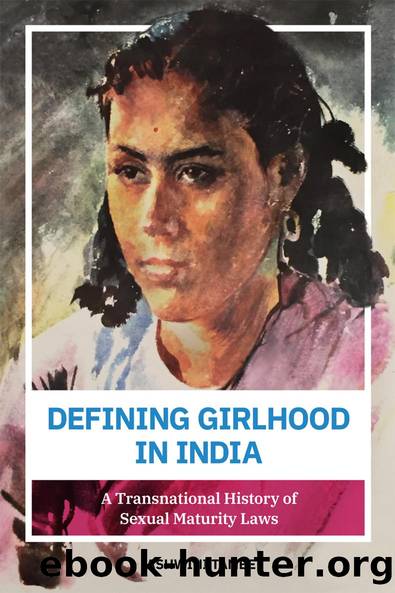Defining Girlhood in India by Ashwini Tambe

Author:Ashwini Tambe [Tambe, Ashwini]
Language: eng
Format: epub
Tags: Social Science, General, Women's Studies, Gender Studies, Law, Gender & the Law
ISBN: 9780252051586
Google: xXOuDwAAQBAJ
Publisher: University of Illinois Press
Published: 2019-10-16T02:44:34+00:00
For much of the twentieth century, the legal age of marriage for girls in India hovered below 15 years. Although Indian officials strenuously refused to follow intergovernmental motions to harmonize a higher common age of marriage in the 1960s, the Indian government finally raised the minimum age of marriage for girls to 18 in 1978. The change happened not because early marriage was framed by the UN as slavery or because of womenâs advocacy on behalf of girls; it happened in the interest of meeting demographic targets. In the two decades leading up to this legal measure, population control experts popularized the idea of raising the age of marriage as an instrument for curtailing birthrates. Attention shifted away from how early marriage harmed girls to how later marriage benefited populations as a whole. This shift, which made feminists deeply uneasy, exemplified a split between the principles of population control and reproductive autonomy. India and Indian experts figured prominently in this shift. While British and American scholars such as Thomas Robert Malthus and Paul Ehrlich, are famously associated with promoting population control, Indian scholars such as S. N. Agarwala and research in India such as the Mysore Study influenced the trajectory of global population studies in the reverse direction and specifically concerning the topic of marriage age. This chapter recounts the process by which demographic certitudes about marriage age were established and implemented in India and were simultaneously contested by Indian feminists.
Exploring how the age of marriage became entwined with population control reveals many twists in demographic writing in the 1960s. Both US and Indian experts participated in popularizing the idea that delaying marriage reduced population, and the idea took root in India very quickly, even as Indian feminist demographers dissented from their fieldâs new orthodoxies. Revisiting this historical moment makes clear the broad power of population control discourses in shaping the destiny of girlsâ bodies.
* * *
When, in 1978, the Indian parliament raised the age of marriage to 18 years for girls and 21 years for boys, the measure created barely a ripple. What was at stake was remarkable: since 1929, when the Child Marriage Restraint Act (CMRA or Sarda Act) had set the age of marriage as 14 for girls and 18 for boys, the age of marriage had not been changed except for a minor amendment to 15 for girls in 1949.1 The age of marriage was being dramatically raised after three decades, but few legislators marked the moment as noteworthy. As a February 22, 1978, Times of India (Mumbai) article observes: âEven though the measure [was] of vital social significance, the attendance in the chamber was poor,â the debate was âlackadaisical,â and âa bell had to be rung to draw in enough members to fulfill a quorum for passage.â
This lack of interest in the measure is mirrored in scholarly writing: only a handful of books and articles actually focus on this event.2 The neglect of this episode appears genuinely surprising when contrasted with the scholarly treatment of
Download
This site does not store any files on its server. We only index and link to content provided by other sites. Please contact the content providers to delete copyright contents if any and email us, we'll remove relevant links or contents immediately.
Tasting Mother-In-Law (Mother In Law Son In Law Erotic & Taboo Short Story) (Naughty In Law Book 3) by Rush Penny(378)
Carl Schmitt Between Technological Rationality and Theology by Hugo E. Herrera;(339)
The Love Conspiracy: An Age-Gap Lesbian Romance by Arias J.J(323)
EARLY GRAVE (Jake Lassiter Legal Thrillers Book 12) by Paul Levine(323)
The Rise of Critical Islam by Youcef L. Soufi(321)
HABEAS PORPOISE (Solomon vs. Lord) by Levine Paul(316)
Tor and the Dark Net · Remain Anonymous Online and Evade NSA Spying (Tor, Dark Net, Anonymous Online, NSA Spying) by Smith James(308)
Natural Rights on the Threshold of the Scottish Enlightenment by Unknown(303)
If We Burn by Vincent Bevins(297)
Democratic Quality in Southern Europe by Tiago Fernandes(295)
Toward revealing the controversy of bacterial biosynthesis versus bactericidal properties of silver nanoparticles (AgNPs): bacteria and other microorganisms do not per se viably synthesize AgNPs by Fatthy Mohamed Morsy(271)
Light-evoked depolarizations in the retina of <Emphasis Type="Italic">Strombus <Emphasis>: Role of calcium and other divalent cations by Unknown(260)
Women before the court by Lindsay R. Moore(227)
When Hope and History Rhyme by Douglas Burgess(209)
The Crimes of Womanhood by A. Cheree Carlson(206)
International Humanitarian Law and Justice by Mats Deland Mark Klamberg Pål Wrange(205)
A New Daddy by orphan_account(205)
To Raise and Discipline an Army by Joshua Kastenberg(203)
Witches, Wife Beaters, and Whores by Elaine Forman Crane(198)
